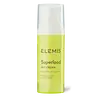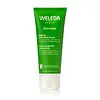What's inside
What's inside
 Key Ingredients
Key Ingredients

 Benefits
Benefits

 Concerns
Concerns

 Ingredients Side-by-side
Ingredients Side-by-side

Water
Skin ConditioningDicaprylyl Carbonate
EmollientGlycerin
HumectantC12-16 Alcohols
EmollientPentaerythrityl Distearate
EmulsifyingIsononyl Isononanoate
EmollientAlpha-Glucan Oligosaccharide
CleansingCucumis Sativus Oil
EmollientCitrus Nobilis Fruit Extract
MaskingRaphanus Sativus Seed Extract
Skin ConditioningSalvia Hispanica Seed Oil
MoisturisingPhenoxyethanol
PreservativePropanediol
SolventPalmitic Acid
EmollientHydrogenated Lecithin
EmulsifyingSodium Polyacrylate
AbsorbentSodium Stearoyl Glutamate
CleansingChlorphenesin
AntimicrobialXanthan Gum
EmulsifyingLycium Chinense Stem Extract
Skin ConditioningTocopherol
AntioxidantBrassica Oleracea Italica Seed Oil
EmollientLactobionic Acid
BufferingParfum
MaskingPanthenol
Skin ConditioningSodium Dehydroacetate
PreservativeLimonene
PerfumingCitrus Aurantium Dulcis Peel Oil
MaskingCamellia Sinensis Leaf Powder
ExfoliatingAmyris Balsamifera Bark Oil
MaskingCymbopogon Martini Oil
Masking1,2-Hexanediol
Skin ConditioningGeraniol
PerfumingLinalool
PerfumingRosmarinus Officinalis Leaf Oil
MaskingDaucus Carota Sativa Seed Oil
EmollientPolyglyceryl-3 Diisostearate
EmulsifyingLactobacillus
Skin ConditioningZingiber Officinale Root Extract
MaskingCaramel
Cosmetic Colorant3-O-Ethyl Ascorbic Acid
Skin ConditioningLecithin
EmollientHelianthus Annuus Seed Oil
EmollientPotassium Sorbate
PreservativeSodium Benzoate
MaskingAscorbic Acid
AntioxidantBenzyl Alcohol
PerfumingMaltodextrin
AbsorbentLonicera Caprifolium Flower Extract
PerfumingLonicera Japonica Flower Extract
Skin ConditioningRosmarinus Officinalis Leaf Extract
AntimicrobialChlorophyllin-Copper Complex
AntioxidantBenzoic Acid
MaskingDehydroacetic Acid
PreservativeWater, Dicaprylyl Carbonate, Glycerin, C12-16 Alcohols, Pentaerythrityl Distearate, Isononyl Isononanoate, Alpha-Glucan Oligosaccharide, Cucumis Sativus Oil, Citrus Nobilis Fruit Extract, Raphanus Sativus Seed Extract, Salvia Hispanica Seed Oil, Phenoxyethanol, Propanediol, Palmitic Acid, Hydrogenated Lecithin, Sodium Polyacrylate, Sodium Stearoyl Glutamate, Chlorphenesin, Xanthan Gum, Lycium Chinense Stem Extract, Tocopherol, Brassica Oleracea Italica Seed Oil, Lactobionic Acid, Parfum, Panthenol, Sodium Dehydroacetate, Limonene, Citrus Aurantium Dulcis Peel Oil, Camellia Sinensis Leaf Powder, Amyris Balsamifera Bark Oil, Cymbopogon Martini Oil, 1,2-Hexanediol, Geraniol, Linalool, Rosmarinus Officinalis Leaf Oil, Daucus Carota Sativa Seed Oil, Polyglyceryl-3 Diisostearate, Lactobacillus, Zingiber Officinale Root Extract, Caramel, 3-O-Ethyl Ascorbic Acid, Lecithin, Helianthus Annuus Seed Oil, Potassium Sorbate, Sodium Benzoate, Ascorbic Acid, Benzyl Alcohol, Maltodextrin, Lonicera Caprifolium Flower Extract, Lonicera Japonica Flower Extract, Rosmarinus Officinalis Leaf Extract, Chlorophyllin-Copper Complex, Benzoic Acid, Dehydroacetic Acid
Water
Skin ConditioningHelianthus Annuus Seed Oil
EmollientLanolin
EmollientPrunin
AntioxidantPrunus Amygdalus Dulcis Protein
Skin ConditioningPrunus Amygdalus Dulcis Oil
Skin ConditioningCera Alba
EmollientAlcohol
AntimicrobialSoy Acid
EmollientCalcium Ascorbate
AntioxidantGlycerin
HumectantLimonene
PerfumingViolacein
AntimicrobialViola Tricolor Extract
EmollientEel Extract
HumectantHydrolyzed Beeswax
EmulsifyingSorbitan Olivate
EmulsifyingRosmarinic Acid
AntioxidantSalvia Officinalis Oil
MaskingChamomilla Recutita Flower Extract
MaskingCalendula Officinalis Flower Extract
MaskingArginine
MaskingZinc
AntioxidantZinc Sulfate
AntimicrobialParfum
MaskingLinalool
PerfumingGeraniol
PerfumingCitral
PerfumingCoumarin
PerfumingWater, Helianthus Annuus Seed Oil, Lanolin, Prunin, Prunus Amygdalus Dulcis Protein, Prunus Amygdalus Dulcis Oil, Cera Alba, Alcohol, Soy Acid, Calcium Ascorbate, Glycerin, Limonene, Violacein, Viola Tricolor Extract, Eel Extract, Hydrolyzed Beeswax, Sorbitan Olivate, Rosmarinic Acid, Salvia Officinalis Oil, Chamomilla Recutita Flower Extract, Calendula Officinalis Flower Extract, Arginine, Zinc, Zinc Sulfate, Parfum, Linalool, Geraniol, Citral, Coumarin
 Reviews
Reviews

Ingredients Explained
These ingredients are found in both products.
Ingredients higher up in an ingredient list are typically present in a larger amount.
Geraniol is used to add fragrance/parfum to a product. It is the main component of citronellol. It is a monoterpenoid and an alcohol.
Monoterpenes are naturally found in many parts of different plants.
Geraniol can be found in many essential oils including Rose Oil and Citronella Oil. The scent of Geraniol is often described as "rose-like". Many foods also contain Geraniol for fruit flavoring.
Geraniol can irritate the skin when exposed to air. However, irritation depends on the ability of geraniol to penetrate into the skin. In general, geraniol is not able to penetrate skin easily.
Geraniol is colorless and has low water-solubility. However, it is soluble in common organic solvents.
Like citronellol, it is a natural insect repellent.
2,6-Octadien-1-ol, 3,7-dimethyl-, (2E)-
Learn more about GeraniolGlycerin is already naturally found in your skin. It helps moisturize and protect your skin.
A study from 2016 found glycerin to be more effective as a humectant than AHAs and hyaluronic acid.
As a humectant, it helps the skin stay hydrated by pulling moisture to your skin. The low molecular weight of glycerin allows it to pull moisture into the deeper layers of your skin.
Hydrated skin improves your skin barrier; Your skin barrier helps protect against irritants and bacteria.
Glycerin has also been found to have antimicrobial and antiviral properties. Due to these properties, glycerin is often used in wound and burn treatments.
In cosmetics, glycerin is usually derived from plants such as soybean or palm. However, it can also be sourced from animals, such as tallow or animal fat.
This ingredient is organic, colorless, odorless, and non-toxic.
Glycerin is the name for this ingredient in American English. British English uses Glycerol/Glycerine.
Learn more about GlycerinHelianthus Annuus Seed Oil is the oil derived from the seeds of a Sunflower. Sunflower seed oil is non-fragrant. It is an emollient, meaning it helps to soften the skin.
Sunflower seed oil contains many fatty acids. The fatty acids found in sunflower seeds include (from highest amount to least): linoleic acid, myristic acid, palmitic acid, stearic acid, arachidic acid, oleic acid, and linolenic acid.
These fatty acids help the skin create ceramides. Ceramides play a role in repairing the skin barrier.
Helianthus Annuus Seed Oil helps moisturize the skin. This in turn helps the skin look more rejuvenated and smoother.
Sunflowers are rich in vitamin E.
Historians believe Indigenous cultures of North America domesticated sunflowers before corn. Thus they relied on sunflower oil for a variety of uses. One such use is moisturizing skin and hair.
Sunflower seed oil may not be fungal acne safe. We recommend speaking with a professional if you have any concerns.
Learn more about Helianthus Annuus Seed OilLimonene is a fragrance that adds scent and taste to a formulation.
It's found in the peel oil of citrus fruits and other plants such as lavender and eucalyptus. The scent of limonene is generally described as "sweet citrus".
Limonene acts as an antioxidant, meaning it helps neutralize free radicals.
When exposed to air, oxidized limonene may sensitize the skin. Because of this, limonene is often avoided by people with sensitive skin.
The term 'fragrance' is not regulated in many countries. In many cases, it is up to the brand to define this term. For instance, many brands choose to label themselves as "fragrance-free" because they are not using synthetic fragrances. However, their products may still contain ingredients such as essential oils that are considered a fragrance.
Learn more about LimoneneLinalool is a fragrance and helps add scent to products. It's derived from common plants such as cinnamon, mint, citrus, and lavender.
Like Limonene, this ingredient oxidizes when exposed to air. Oxidized linalool can cause allergies and skin sensitivity.
This ingredient has a scent that is floral, spicy tropical, and citrus-like.
Learn more about LinaloolParfum is a catch-all term for an ingredient or more that is used to give a scent to products.
Also called "fragrance", this ingredient can be a blend of hundreds of chemicals or plant oils. This means every product with "fragrance" or "parfum" in the ingredients list is a different mixture.
For instance, Habanolide is a proprietary trade name for a specific aroma chemical. When used as a fragrance ingredient in cosmetics, most aroma chemicals fall under the broad labeling category of “FRAGRANCE” or “PARFUM” according to EU and US regulations.
The term 'parfum' or 'fragrance' is not regulated in many countries. In many cases, it is up to the brand to define this term.
For instance, many brands choose to label themselves as "fragrance-free" because they are not using synthetic fragrances. However, their products may still contain ingredients such as essential oils that are considered a fragrance by INCI standards.
One example is Calendula flower extract. Calendula is an essential oil that still imparts a scent or 'fragrance'.
Depending on the blend, the ingredients in the mixture can cause allergies and sensitivities on the skin. Some ingredients that are known EU allergens include linalool and citronellol.
Parfum can also be used to mask or cover an unpleasant scent.
The bottom line is: not all fragrances/parfum/ingredients are created equally. If you are worried about fragrances, we recommend taking a closer look at an ingredient. And of course, we always recommend speaking with a professional.
Learn more about ParfumWater. It's the most common cosmetic ingredient of all. You'll usually see it at the top of ingredient lists, meaning that it makes up the largest part of the product.
So why is it so popular? Water most often acts as a solvent - this means that it helps dissolve other ingredients into the formulation.
You'll also recognize water as that liquid we all need to stay alive. If you see this, drink a glass of water. Stay hydrated!
Learn more about Water